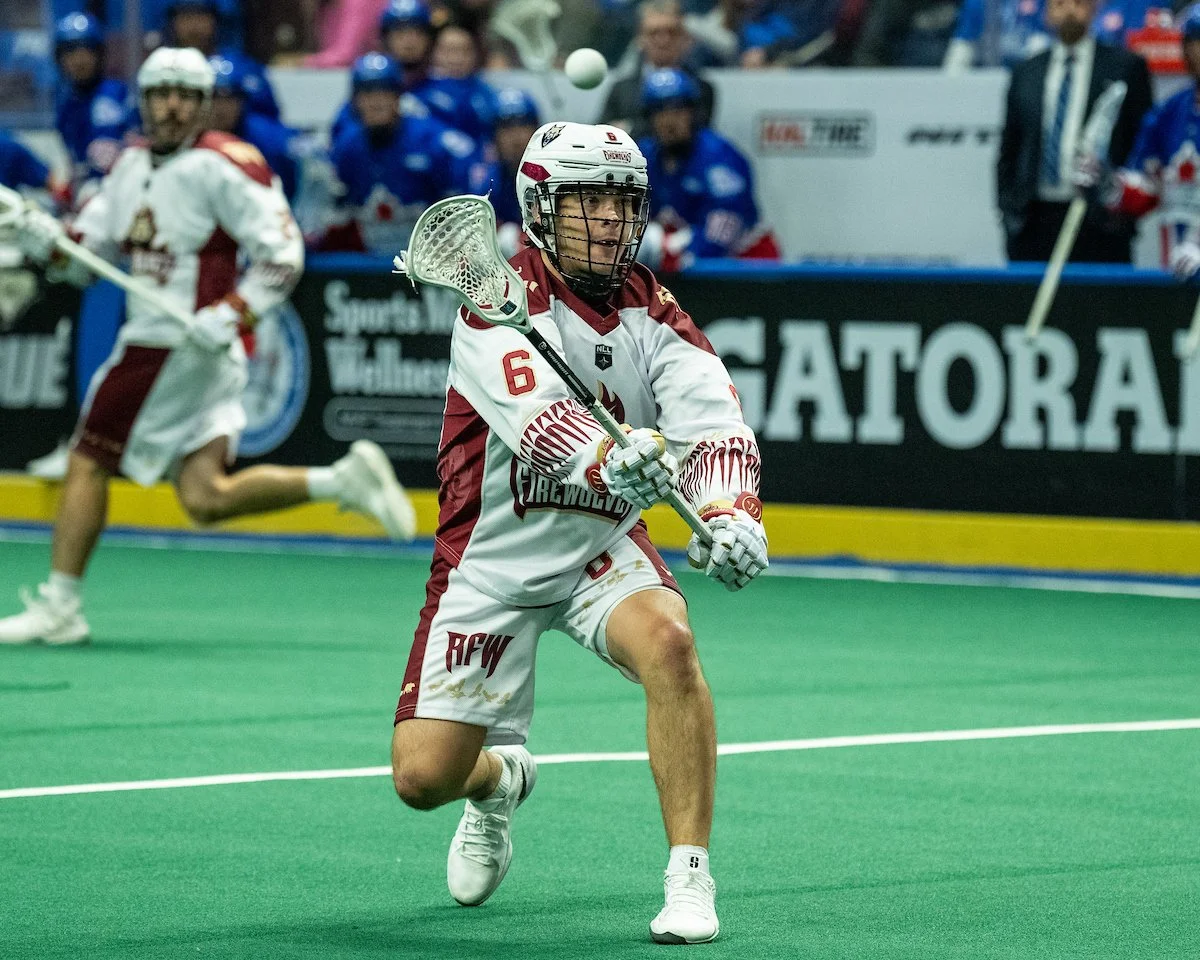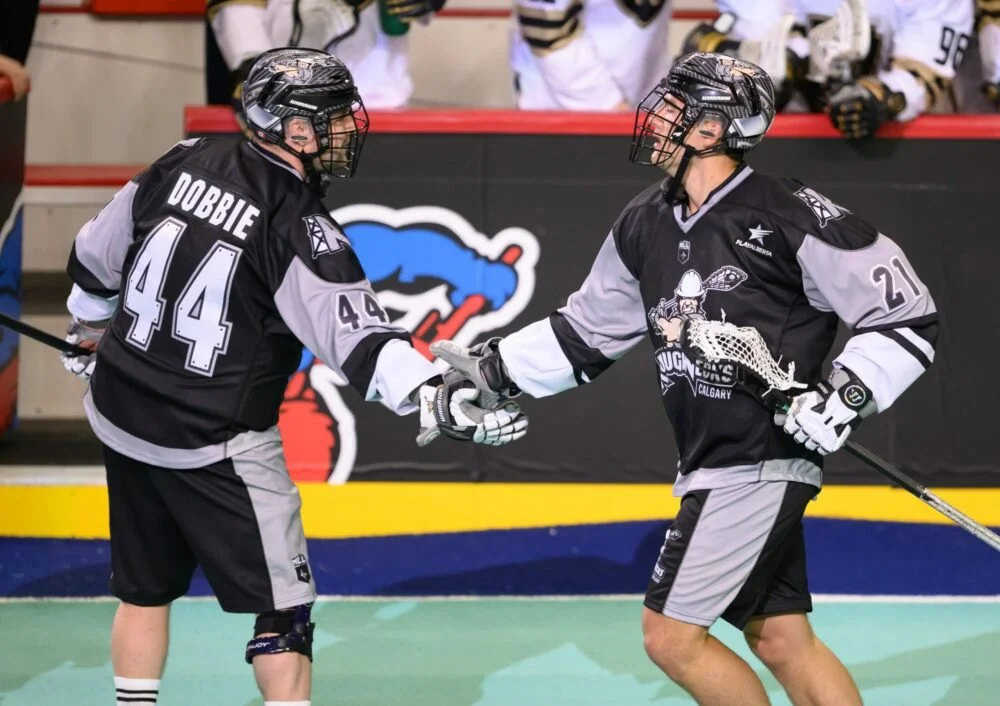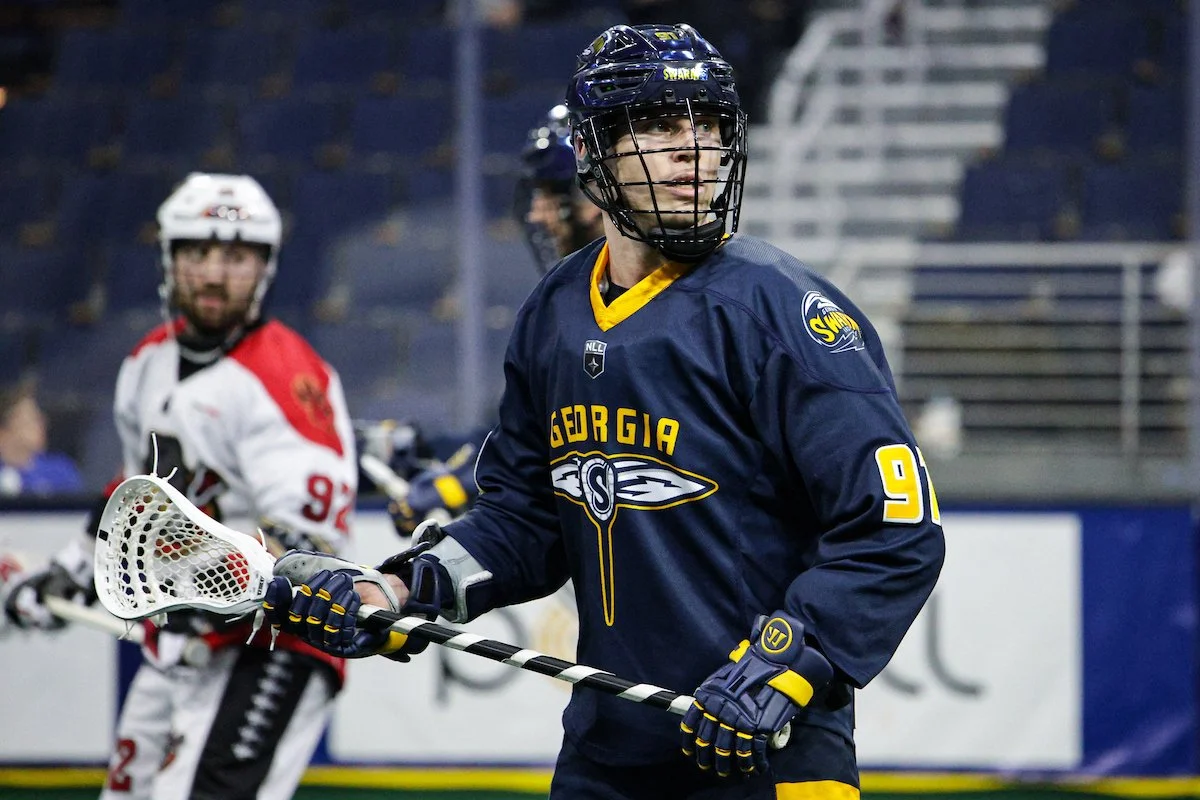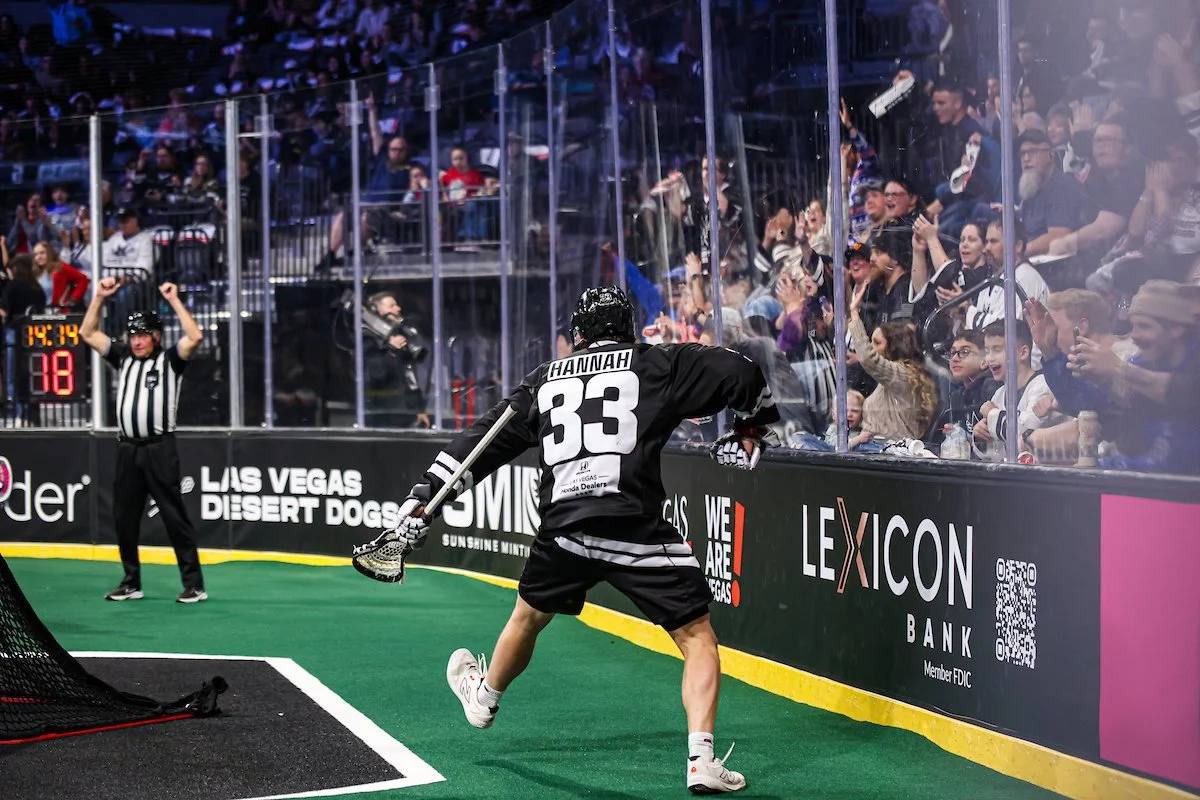Thoughts 1/3 of the Way Through the 2024-25 NLL Season — pt. 1
I rattle through half the NLL teams, writing down my thoughts on them with roughly a third of the season behind us
Photo Credit: J. Brooking/Albany FireWolves
One of the worst things about this entire statistical project I maintain is how much nuance I miss when watching games. The speed at which I review tapes so getting all the data necessary doesn’t bleed into the day job means the finer points of NLL action I notice when watching live fall by the wayside; there’s a lot to process, and while all of what I watched is jammed into my noggin, it is haphazardly stuck in there. It’s the nature of the beast; my personal insights take a hit to provide information I consider necessary to help grow the NLL by educating fans.
This issue really reared its ugly head last season when I was with IL Indoor and had to pick who I thought should win certain end of season awards. I didn’t feel as confident as I thought I should in who I was picking to win what award (except for Owen Grant to win Rookie of the Year), and if not for my colleague Cooper Perkins’ incredible work at LaxMetrics.com (now unfortunately defunct), I probably wouldn’t have submitted any ballot at all.
Now, it’s just an issue that annoys the hell out of me. There aren’t enough hours in the day to sit back and devote the appropriate amount of time to thinking about the NLL and all 14 teams, what I’ve noticed, their eye-test strengths and flaws. Sure, there are times when I’m not doing the day job that I could use for that exercise, but man, all of this is a passion project of mine — I’m not letting my mentals and relationships take a hit again for no scratch.
Yet, this issue has been more nagging lately, and with a third of the 2024-25 NLL season down, I figured why not spend some time trying to collect those aforementioned thoughts on each team, organize them and back up whatever I need to with stats. It’ll help me feel caught up with the sport, and with how quickly I’ll get through this, I’ll have plenty of time to spend reading Dan Simmons The Rise of Endymion tonight.
So with Scratch Bandits Crew 31 Novembre soundtracking this exercise, here are some quick thoughts on seven of the 14 NLL teams. Part 2 will drop Thursday.
Photo Credit: Christian Bender/Toronto Rock
Albany FireWolves (2-5)
I’m a big fan of addition by subtraction, which I think is what the FireWolves did when they traded Eric Fannell to the Ottawa Black Bears. The grittiest of off-ball forwards, Fannell’s style of play didn’t really fit into a FireWolves offense that’s dependent on zipping the ball around and taking advantage in half-windows of opportunity. While it’s just one game, their win in the rematch against the Colorado Mammoth showed early signs that slimming down was the correct move for them. Their TrueESE% before that game was 9.3%; they posted a 16.4 TrueESE% last Saturday, their second-best settled efficiency percentage of the season.
Injuries have really hit the FireWolves hard, almost as hard as the decimated Toronto Rock. Travis Longboat, Callum Crawford, John Wagner, Jackson Nishimura, and Colton Watkinson being out have severely tested Albany’s depth. Their steadiest piece has been Doug Jamieson, who is second in the NLL in GSAA (7.37). He’s one of the best netminders at stopping transition. Get a healthy defense in front of him, and Albany’s settled defensive numbers should trend back in the right direction.
Buffalo Bandits (5-0)
They’ll three-peat. It’ll be boring if you love parity and aren’t a Bandits fan. It’ll be great for the NLL when their best market sells out every postseason contest again.
Buffalo has one of the top two offenses in the NLL and just seems absolutely unstoppable at times. But there are worrying signs of late — you know, worrying in the way Goliath felt when David walked up with a rock and some leather; shoot your shot, little man, and hope your aim is true. I don’t know which other NLL team is David in this metaphor.
The Bandits power play is third worst in the league, with a 14.8 TruePPE%. Averaging 1.8 PPG/GAME means the Bandits haven’t capitalized as often as they should have on their 24 power plays in five games. Their shot-on-goal percentage on their 61 TruePPSets is the worst in the NLL at 61.2%. That said, the Bandits dominate even strength (17.4 E%, second best in the NLL) and transition (22.0 E%, also second best in the NLL) — it’s a blessing for the rest of the NLL that Buffalo’s been badbadnotgood on the man-advantage.
Matt Vinc has also looked human of late. In his first three games, he had a 6.85 GAA and .865 Sv%. His GSAA was nearly in double digits, which is insane for just three games. Over the last two, he has a 13.50 GAA and .693 Sv%. You’d think that would ruin his season stats, but nah. Duder has a 9.55 GAA and .801 Sv% this season. Father Time can’t catch the best goalie in the NLL’s history.
Photo Credit: Calgary Roughnecks
Calgary Roughnecks (3-2)
Not to seem too focused on goalies, but the biggest storyline around the Roughnecks this season centered on a former MVP refusing to report and them having to put Cam MacLeod, who had zero professional starts before December, in between the pipes. He was really bad for three games; I wrote about it already.
But the last pair of games has been really promising, even if the team’s gone 1-1 in that short span. The 25-year-old has an 11.18 and .770 Sv% in the new year, holding what I’d argue is the best offense in the NLL in the Philadelphia Wings to just 12 goals (not counting their empty netter). There are still going to be growing pains for him and this defense, but with an offense that’s top 5 in scoring (12.8 GF/GAME) and settled offense (12.9 TrueESE%), Calgary can weather his frenetic growth spurts as he learns on the fly.
Also, how ’bout Brayden Mayea and Bennett Smith? Mayea’s been electric in his first two games, a noticeable spark plug on that left side. And Smith’s growth in his sophomore season isn’t getting the due it deserves — smart, gritty defense with an ability to cash in on transition. Big fan of both their games.
Colorado Mammoth (4-3)
I forgot to mention Will Malcom when I spoke about why I was such a fan of Colorado’s offense in a previous article, and it’s haunted me ever since. I don’t think there’s a team that’s as balanced out the front door as the Mammoth. They’re similar to the Bandits in the fact that they do their damage 5-on-5 but aren’t seeing as much success on the power play; Colorado’s transition game isn’t as strong — hell, it’s the second worst in the NLL (14.7 TrueFBE%) — and their shorthanded efforts aren’t bearing as much fruit as they desire (2.9 TrueSHE%, third worst in the NLL).
It’s weird because their defense follows a similar trend: the Mammoth are good defensively while settled (11.4 TrueESE%, sixth best) but bad on the penalty kill (23.5 TruePKE%, worst) and at giving up shorthanded goals (14.3 TrueSHE%, third worst). Special teams aren’t where the Mammoth’s strengths are at, and if they clear those issues up, then we’ll probably see them playing in the NLL Finals again.
One thing I would really like to see this defense get better at is forcing opposing forwards to not record a shot against. Their LP% while settled is 19.3%, second worst in the NLL (league average is 22.3%). Getting closer to having opponents waste one out of every four settled possessions instead of five is only going to help their even strength defensive prowess.
Photo Credit: Kyle Hess/Georgia Swarm
Georgia Swarm (4-3)
No Adam Wiedemann and Jeff Henrick is hurting the Swarm defense. While Wiedemann was in their last win, he left that game against the Mammoth injured. In their four most recent games, the Swarm defense hasn’t had a TrueESE% lower than 14.1% — league average is 12.5%. Coupled with their recent trio of games where the team is getting dominated at the face-off dot (25-84, a 29.8 FOW%) means the shorthanded defense is working overtime. Credit where it’s due, Brett Dobson bounced back from a rough trio of games with a solid effort in the loss to Calgary’s high-powered offense, an effort he’s sure to build upon.
The Swarm have had a scoring problem for a minute now, averaging 11.0 GF/GAME over their last 25 regular season contests. No one surpassed 90 points on the team last season (Lyle Thompson and Andrew Kew both had 87 points), and only Thompson is currently on pace for 100 points this season. While Bryan Cole has somehow taken his game to another level — again —, the lack of secondary scoring from the Swarm is hard to ignore. Both Seth Oakes and Shayne Jackson are on pace to finish under 50 points this season.
Georgia’s run game has taken a step back from its hot start to the season, the power play is hit-or-miss, and the settled offense is in the bottom third of the league in efficiency. A team with two former MVPs and Kew isn’t putting the ball in the back of the net enough, and with underperforming secondary scoring, it makes defenders’ jobs easier, allowing them to focus more on Thompson and Kew.
Halifax Thunderbirds (2-4)
The defense is the issue.
It doesn’t matter who you put in net, Warren Hill (12.67 GAA, .764 Sv%, -3.06 GSAA) and Drew Hutchison (14.71 GAA, .717 Sv%, -6.98 GSAA) are getting hung out to dry too often. Hill had his best effort of the season in the rematch against the Knighthawks, a game in which it was easier to point at the other side of the floor and say an offense that averages 13.3 GF/GAME should’ve scored two more goals. But he and Hutchison have played behind a switch-happy defense, one that makes everyone look bad when opposing forwards are left with time and room.
The team as a whole is slow, too. The defense has a 25.3 TrueFBE%, the worst in the league by over two percentage points. Part of that is an offense that can’t sub off quickly enough or keep up in reverse transition. It’s been a focus for opponents in their last trio of games, as the Thunderbirds have been outscored 6-13 in TrueFB goal differential — half of those 13 FBGA came from the seven-spot the Knighthawks tagged them with in their first contest against one another, a Thunderbirds win.
I predicted preseason that the Thunderbirds would miss the postseason, but this wasn’t exactly how I imagined it happening actually, this is probably exactly how it was going to happen. The offense is exceptional, if slow; Thomas Hoggarth, Jason Knox, and Mike Robinson fit comfortably in that system. Bench Wake:Riat Bowhunter for a game or two, see what happens (addition by subtraction). He’s a point- and turnover-per-game player in his NLL career, which is really underwhelming. The defense being all over the place wasn’t in my crystal ball.
Photo Credit: K. Morrow/Las Vegas Desert Dogs
Las Vegas Desert Dogs (2-5)
Another case of addition by subtraction, the Desert Dogs offense looks much better with Jackson Webster in and Dan Taylor and Dylan Watson out. Taylor was a casualty of his teammates being unable to cash in off his off-ball efforts, which is a shame given how great he is in that facet of the game. Watson, who averaged 2.0 PTS/GAME during his Desert Dogs tenure, just couldn’t figure it out, and I’m not sure San Diego will be a different story.
I already spoke about how the Desert Dogs were trying to outrun their settled issues, and in their recent wins, that’s still been the case, but the settled offense has managed to string together some impressive goals; in those two wins, Las Vegas averaged 7.0 ESGF.
And a scrappy defense that lets a ton of shots by finally got Justin Geddie healthy enough to slot into the lineup. Landon Kells, who I thought would take a step forward in his development this season, lost the job weeks ago, in my eyes. But Geddie on the PUP List meant the Desert Dogs had to keep running Kells out there. His strong performance against the FireWolves can’t erase his 14.78 GAA, .741 Sv%, and -10.90 GSAA. Geddie currently has a small sample size of 107:23 min. played, but an 11.17 GAA and .808 Sv% while facing 58.11 SA/60 is a much needed shoring up of Vegas’s back end.
Oh yeah, Jack Hannah’s pretty damn good. But we already knew that.




